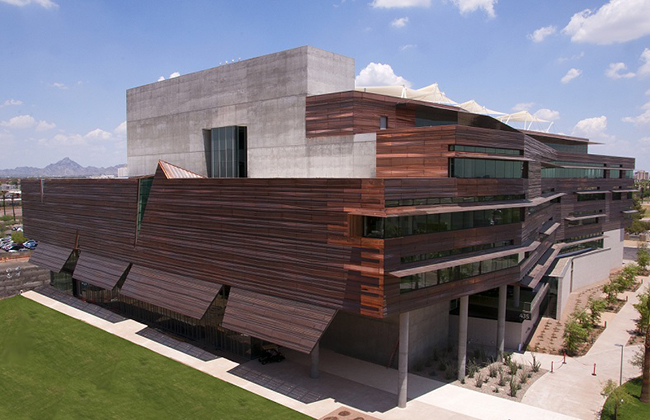Phoenix Biomedical Campus Building Exemplifies Interdisciplinary Teaching, Research
The physical manifestation of a new, interdisciplinary approach to health sciences education and research has risen in downtown Phoenix. The eagerly awaited, 268,000-square-foot Health Sciences Education Building (HSEB) is the newest structure on the 28-acre Phoenix Biomedical Campus.
In an unprecedented collaboration, the six-story, $135 million building was created so the state could expand its medical education facilities. The University of Arizona (UA) College of Medicine – Phoenix has expanded its class size and Northern Arizona University (NAU) has increased its health-related offerings in the building.
The architecturally expressive, sustainable educational facility welcomed students, faculty and researchers from the UA colleges of medicine, pharmacy and public health, as well as NAU’s College of Health and Human Services in 2012.
Not only is the Health Sciences Education Building an impressive architectural icon for the city and state, but it is a fundamentally essential building block to creating a better future for the health of Arizonans,” said Arizona Board of Regents Chair Rick Myers.
More than 300 students are training in this one-of-a-kind interdisciplinary facility that can support up to 1,200 students.
The building’s layout facilitates a trend in medical education to teach interprofessional curricula to groups of students, mirroring the reality of the health care industry in which physicians, nurses, assistants and others work side-by-side.
The Phoenix Biomedical Campus also plays host to the UA College of Pharmacy and the UA Mel and Enid Zuckerman College of Public Health. In addition, NAU has expanded its physical therapy program from Flagstaff to Phoenix and has started a new physician’s assistant program in the building.
This building is a defining example of cooperation, collaboration and integration for education, health care and research and development,” Regent Myers said. “The building is a united effort of the City of Phoenix, the Arizona Board of Regents, the UA, NAU, two architects and two general contractors.”
The building, which includes lecture halls, classrooms, learning studios, a simulation center, anatomy labs and offices, is wrapped by 250,000 pounds of recycled copper fabricated by Kovach Inc. of Chandler, Ariz.
Designed by Los Angeles-based CO Architects and the Phoenix office of Ayers Saint Gross, and constructed by the DPR Construction • Sundt Construction, Inc., Joint Venture, the project was delivered on time and on budget, during one of the most difficult economic times in our country.
HSEB represents collaboration, both in education and architecture,” says Paul Zajfen, FAIA, RIBA, design principal of CO Architects. “The building merges elements of health programs formerly taught separately, and the design/construction process itself is exemplary of the highest level of teamwork.
As a “healthy” building itself, HSEB is targeting LEED®- NC Silver certification, due, in part, to the locally sourced recycled copper cladding, east-west orientation that cuts heat gain, abundant natural light, overhangs and sunshades, and vertical fins that control sun penetration on the north. The architecture is a dramatic response to the structure’s function and to the local climate — inspired by desert earth forms and built from regional materials.
This building signifies the next phase in the development of the campus and its expanding presence in the downtown core,” notes Jack Black, AIA, LEED AP, principal at Ayers Saint Gross’ Phoenix office.
Project Directors Peter Berg, LEED AP and Kent Bosworth, DBIA, LEED AP, whole-heartedly agree, “The DPR • Sundt, Joint Venture is extremely proud to be constructing the landmark HSEB for the downtown Phoenix Biomedical Campus, and to be part of an institution that will serve the State of Arizona for many generations to come.”
